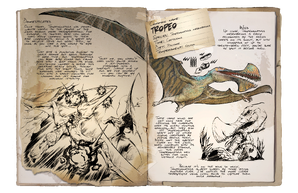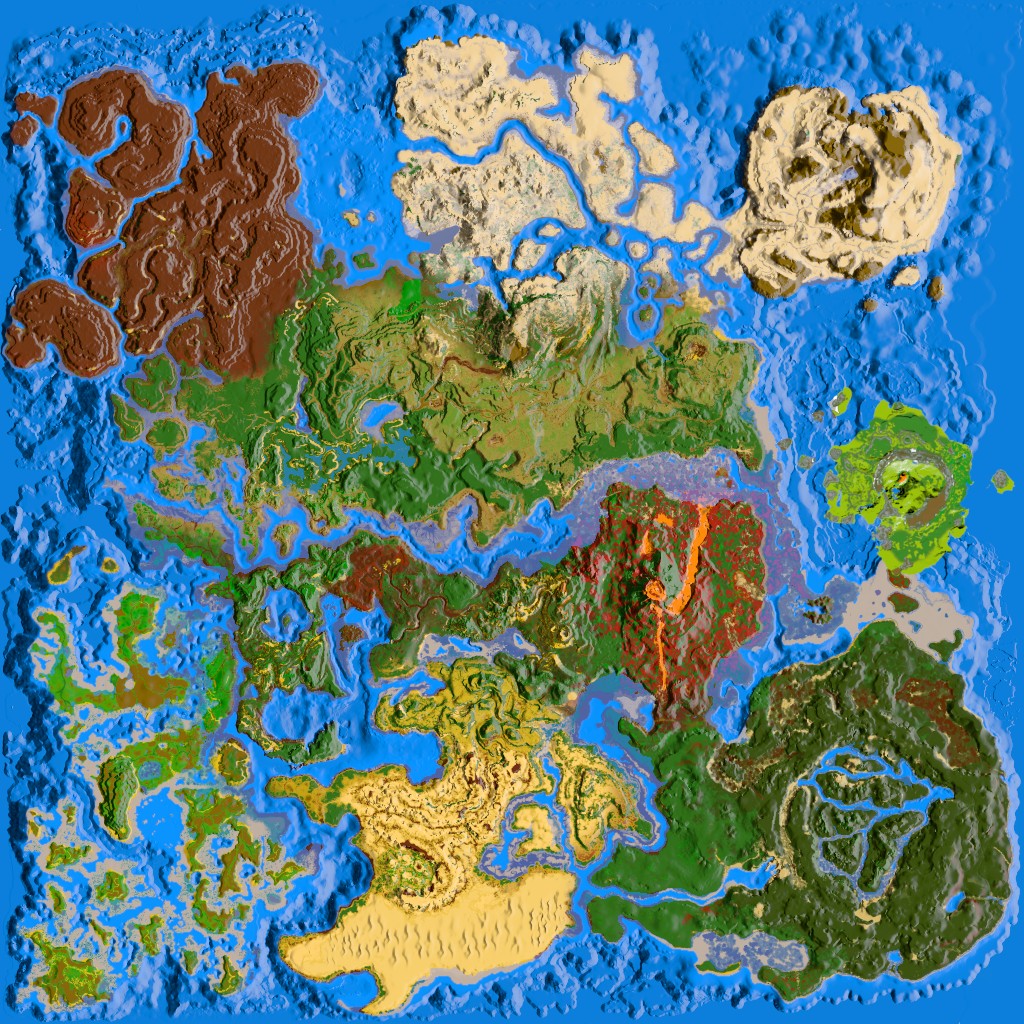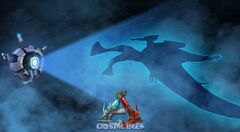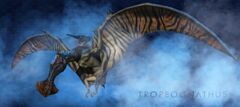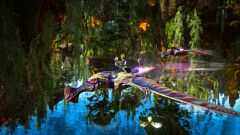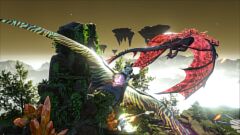Tropeognathus
Common
Rare
Untameable
Cave
| Dieser Artikel enthält nur wenige Informationen zu diesem Thema. Du kannst das ARK Wiki unterstützen, indem du ihn weiter ausbaust. |
Der Tropeognathus ist eine Kreatur aus ARKs Expansion Map Crystal Isles.
Basis Infos
Dossier
Dieser Dossier-Abschnitt ist eine exakte Kopie der Texte der Dossiers, welche die Forscherin Helena geschrieben hat. Es ist möglich, dass es Unterschiede zwischen dem Beschriebenen und dem Verhalten im Spiel gibt.

|
“ |
Aus der Nähe erkennt man Tropeognathus mesembrinus leicht an den gekielten Kämmen auf seiner Schnauze, aber bei Flügelspannweiten von mehr als acht Metern ist er mit Sicherheit vorher zu erkennen. Diese großen Flügel sind nicht nur ideal, um Luftströmungen über seinen Jagdgründen im Ozean einzufangen, sondern sie lassen Tropeognathus Luftströmungen auch von anderen fliegenden Kreaturen abziehen, indem er hinter ihnen herfliegt. Er ist zwar nicht der schnellste Flieger der Inseln, aber in Kombination mit seiner bemerkenswerten Ausdauer eignet sich Tropeognathus deshalb gut für Langstreckenflüge. Da er sich so oft in der Luft befindet, wird Tropeognathus am besten von denen gefangen genommen, die einen anderen Flieger reiten. Mir ist aufgefallen, dass die geschickteren Stammesangehörigen Kettenbolas verwenden, um sie während des Fluges zu fangen.
Einmal gezähmt, hat sich Tropeognathus für die Menschen auf den Inseln über den bloßen Transport hinaus als recht nützlich erwiesen. Zum Beispiel kann sein gezahnter Schnabel viele gewöhnliche Güter bis auf ihre Grundbestandteile zermahlen, was eine großartige Möglichkeit ist, Gegenstände und Ausrüstung zu recyceln! Nun, solange Sie einen Lappen zum Abwischen des Spießes zur Hand haben... Dieser Biss ist strafend genug, um mit der Zeit die Panzerung zu zerbrechen und sich durch sie hindurchzuarbeiten, und Tropeognathus kann Flora und Fauna gleichermaßen mit einer Böe von seinen Flügeln wegpusten. Im Luft-Luft-Kampf glänzt diese Kreatur aber erst richtig. Und mit den richtigen Werkzeugen ist es einigen Überlebenden gelungen, sie mit einer sattelmontierten Flakkanone und einem Düsentriebwerk auszurüsten, um eine maximale Tödlichkeit zu erzielen. Glaubt mir, ihr habt nicht gelebt, bis ihr einen düsengetriebenen Pterosaurier in einen Luftkampf geritten habt. Sattelt einen auf und seht selbst - Ihr könnt jederzeit mein Flügelmann sein! |
„ |
| ~ Helena |
Behavior
Tropeognathus does not show any signs of aggression towards anyone and anything that comes near it, especially when it lands. However, once it gets hit by anything, including ![]() Chain Bola, it will become aggressive towards the said individual. Nearby Tropeognathus will target after anything that attacked it as well (but this is really rare because at one moment there are only few Tropeognathuses on whole map).
Chain Bola, it will become aggressive towards the said individual. Nearby Tropeognathus will target after anything that attacked it as well (but this is really rare because at one moment there are only few Tropeognathuses on whole map).
Appearance
The Tropeognathus size-wise is bigger than a Pteranodon but smaller than a Tapejara, although its wingspan is on par with that of the Quetzal.
Its wings are covered in a striped pattern that ends at the body.
What defines this Pterosaur is its circle-shaped construct on the end of its elongated jaw, said jaw also has sharp jagged teeth.
Color Scheme and Regions
Dieser Abschnitt zeigt die natürlichen Farben und Regionen. Zur Veranschaulichung sind unten die Regionen rot eingefärbt über einem Albino-Tropeognathus. Die farbigen Felder, die unter der Beschreibung jeder Region angezeigt werden, sind die Farben, mit denen Tropeognathus nach dem Zufallsprinzip erzeugt wird, um einen Gesamtumfang des natürlichen Farbschemas zu erhalten. Bewege den Mauszeiger über eine Farbe, um deren Namen und ID anzuzeigen.
Server-Administratoren können die Information einer Region mit dem Konsolenbefehl cheat SetTargetDinoColor <ColorRegion> <ColorID>" nutzen.
Zum Beispiel wird mit cheat SetTargetDinoColor 0 6 die Region Tropeognathus's "main" magenta.
Drops
Base Stats and Growth
Beachte, dass Kreaturen in Survival of the Fittest abweichende Werte haben
| Attribute | Betrag Stufe 1 | Erhöhung pro Punkt | Zähmungs-Bonus | ||
|---|---|---|---|---|---|
| Wild | Domestiziert1 | Add | Mult | ||
| 360 | +72 | +4.86% | 0.07 | ||
| 250 | +12.5 | +5% | |||
| 150 | +15 | +10% | |||
| 1600 | +160 | +10% | 15% | ||
| 340 | +6.8 | +4% | |||
| 182 | +0.9 | +1.7% | 7% | 17.6% | |
| 100% | N/A3 | +0% | 36.5% | ||
| 450 | +27 | N/A4 | 0.5 | ||
1Basierend auf dem Wert des Status im Moment der Zähmung (inkl. Zähmungseffektivität).
2Hier wird der absolute Basisschaden anstelle des Prozentsatzes angezeigt.
3Wilde Kreaturen erhöhen nicht die Bewegungsgeschwindigkeit
4Die Benommenheitsreserve kann nach der Zähmung nicht erhöht werden.
- Für einen Vergleich der Statistiken aller Kreaturen, siehe Basisstatistiken Kreaturen.
- Für eine genaue Erläuterung, wie die Berechnung des Levels funktioniert, siehe Statusberechnung Kreaturen.
| Bewegungs-Typ | Basis-Geschwindigkeit | Sprint | Ausdauer | |
|---|---|---|---|---|
| Wild | Domestiziert | |||
| Gehen | 245 | 539 | 245 | -6 |
| Schwimmen | 300 | N/A | N/A | N/A |
| Fliegen | 700 | 1540 | 700 | -0.325 |
- Dies sind die Basisgeschwindigkeiten der Kreatur bei 100% Bewegungsgeschwindigkeit
- Für einen Vergleich der Geschwindigkeiten aller Kreaturen, siehe Basisgeschwindigkeiten Kreaturen
Wild Stats Level-up
Type in values of a wild creature to see on which stats it's emphasized. Green values on a high-level creature are very good for breeding. If you have already tamed your creature you can try to recover the breeding-stats with an external tool.[1]
The stat-calculator does not work in the mobile-view, see here for alternatives: Apps
Note that after the creature is tamed it gets bonuses on some stats depending on the taming effectiveness. This makes it hard to retrieve the levels on a tamed creature, so this tool is only for wild ones, but gives a first impression, how well the stats are distributed.
Combat
This section describes how to fight against the Tropeognathus.
General
Tropeognathus generally remains passive even if the survivor gets near them. They only becomes aggressive however, if they were provoked via hitting it through any means.
Strategy
The advised strategy for fighting the tropeognathus in the wild is to utilise one of the wyvern variants and their ability to use ranged 'special attacks'. This is due to their high damage and speed, allowing it to kill the tropeognathus quickly and efficiently.
Additionally one may follow the same methods for taming: Immobilize the Tropeognathus using Chain Bolas from a Ballista Turret via a Platform Saddle, preferably on a Quetzal though a Bronto or Paracer may suffice if the Tropeognathus is found flying low enough or on the ground. Once immobilized, dismount and shoot from the platform saddle. This is not recommended for high level Tropeognathus’, the bola will likely not last long enough to kill them.
Weaponry
Almost all modernised long-range weaponry will do the trick while fighting against this creature, solong as you stay far away from its armor-crushing jaws.
Dangers
Its jaw is large enough to break through armor easily. Additionally, they can pull you off a mount and fly high enough to cause a freed survivor to take high amounts of fall damage.
Weakness
They are very slow compared to other flyers
Taming
Für allgemeine Infos über die Domestizierung von wilden Kreaturen siehe Zähmen.
Taming Food
Keine Ergebnisse
Preferred Food
Passive Tame Strategy
Tropeognathus is tamed non-violently, rather than through the use of tranquilizers. However, in order to trigger a way of feeding the creature, it has to be held in position with a ![]() Chain Bola. Since it does not attack until it has been provoked the first time, chaining it down in bola will turn it aggressive against the individual.
Chain Bola. Since it does not attack until it has been provoked the first time, chaining it down in bola will turn it aggressive against the individual.
One of the few ways is to set a trap structure with the ![]() Ballista Turret in another end with the Chain Bola, and pull it over towards the trap area.
Ballista Turret in another end with the Chain Bola, and pull it over towards the trap area.
Utility
Tropeognathus has several utilities as a flying creature. It acts as a portable ![]() Industrial Grinder; when grindable product are placed inside, there is an option to grind them down below "Show Ancestry" when selected. Moreover, its saddle,
Industrial Grinder; when grindable product are placed inside, there is an option to grind them down below "Show Ancestry" when selected. Moreover, its saddle, ![]() Tropeognathus Saddle has two function if ridden with one:
Tropeognathus Saddle has two function if ridden with one:
- The jet fitted in the saddle can be activated and deactivated at command. While active, the jet increases the speed movement of Tropeognathus, rivaling even ridden
 Wyvern. It can be further boosted while active to move faster. Activating and maintaining the jet requires
Wyvern. It can be further boosted while active to move faster. Activating and maintaining the jet requires  Gasoline in its inventory.
Gasoline in its inventory.
- While flying very fast with jet, pressing a specific button (C on PC) (the right stick for Xbox) will cause Tropeognathus to do an evasive maneuver to another direction.
- The turret fitted in the saddle fires out explosive projectiles when launched. A crosshair shows up at the current direction the survivor is facing with the saddle and Tropeognathus which determines where the next projectile will land if shot. It takes in
 Grenade as its source of ammo in its inventory.
Grenade as its source of ammo in its inventory. - Double tapping Spacebar on PC will push dinos and players away from the Tropeognathus. This can be used in Air and whilst sitting
- Whilst flying you can pick up small dinos and other players by using right click on PC
Roles
- Grinder: It can be utilized with its jaws to grind down product to its relevant material.
- Hellfire Hit-and-run(Strafing): With the Jet and Turret and its corresponding item, Tropeognathus can be utilized as a means of either dogfight against the Wyvern and Pteranodon riders, or firing downwards as a means of damaging Stone Structures, or in PvE instance, attacking and damaging both creatures and
 Titan alike.
Titan alike. - Wyvern Egg Stealer: With the jetpack saddle and enought gasoline, it is very easy to out-fly Wyverns once in an open area. Be mindful of tight spaces you may get stuck on, specially on The Wyvern Cave in Ragnarok. (Level Stamina. Weight as needed)
- On PC, use the Ctrl key to activate the jet. On Xbox, click RS to activate and hold RS to deactivate. The jet has two move speeds, a “walk” and “sprint” mode, though the Tropeognathus itself seems to have only one move speed while equipped with the saddle. While the “Walk” Jet is active, pressing the forward movement key will give a minor boost to speed accompanied by a minor increase to Gasoline drain. Additionally, while nearby another flyer, the Tropegnathus can gain a drafting buff, this is indicated by a wing with green arrows. While the buff is active, pressing and holding the Jump button will result in an increase in speed and gasoline consumption. With minimal testing it appears that drafting in the “Walk” Jet mode brings the speed up to about the same as being in the “Sprint” Jet mode, though at an apparently lower Gasoline consumption rate than the “Sprint” Jet mode. Doing this while in the “Sprint” Jet mode appears increase speed and Gas consumption rate, to the same rate but more speed as when diving (when you dive with draft, you will have the same speed). The “Sprint” Jet mode will give the jet and extra boost, and diving will give it another boost in gasoline comsumption, but not in speed (tested with the Speedometer Mod). Sprinting consumes both gasoline and stamina, while just the jet alone will consume gasoline and a very low ammount of stamina.
- Tapejara+: As it stands right now, directly after the Tropeognathus’ release, it is essentially a Tapejara+. It sports higher base health and weight than the Tappy while having only a minor loss once tamed, has higher speed than the Tappy when utilizing the jetpack, has the same up/down and front/back mobility as the Tappy, sports a grenade launcher, shreds armor, can use its knockback in the air, and acts as a grinder.
Collectibles
| Ressource | Effizienz |
|---|---|
| N/A | |
| N/A |
Spotlight
Notes/Trivia
Für Fragen, die sich auf Informationen zum Thema Tropeognathus in der Realität beziehen, lese den relevanten Wikipedia Artikel
- Tropeognathus mesembrinus roughly translates to "southern keel jaw."
- “The Tropeognathus currently possesses the same sounds as the Tapejara.”
- It is the first creature to have a jet engine on its saddle.
- The Tropeognathus model and sounds have a strong resemblance to the
 Tapejara,
Tapejara,  Microraptor has same issues as well, as it is resemble to
Microraptor has same issues as well, as it is resemble to  Archaeopteryx.
Archaeopteryx. - On its release, Tropeognathus will be exclusive to Crystal Isles. In Consoles however, it will appear at other maps until its map releases, after which they will only be strictly exclusive to that map. [1]
Gallery
References
| Kreaturen | |||||||||||||||||||||||||||||||||||||||||||||||||||||||||
|---|---|---|---|---|---|---|---|---|---|---|---|---|---|---|---|---|---|---|---|---|---|---|---|---|---|---|---|---|---|---|---|---|---|---|---|---|---|---|---|---|---|---|---|---|---|---|---|---|---|---|---|---|---|---|---|---|---|
| |||||||||||||||||||||||||||||||||||||||||||||||||||||||||
- Seiten, die DynamicPageList3 dplvar parser function nutzen
- Pages using Tabber parser tag
- Breedable creatures
- Stubs

